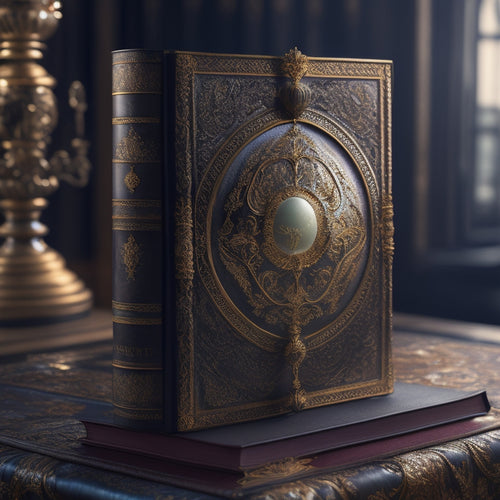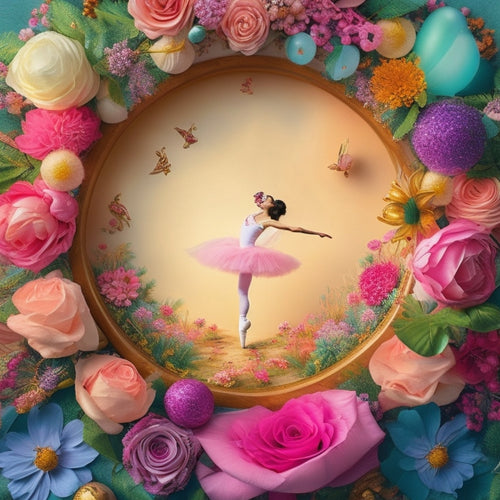
Why Intermediate Dancers Need Perfect Music Playlists
Share
As you level up as an intermediate dancer, you're not just perfecting moves - you're developing a narrative that resonates with your audience. And that's where the ideal music playlist comes in. You need a playlist that evokes the right emotions, boosts your confidence, and showcases your unique style. The right tempo, energy, and cultural authenticity can make all the difference in engaging your crowd and perfecting your choreography flow. But, it's not just about the individual tracks - it's about creating a cohesive vibe that flows seamlessly from start to finish. Discover the secrets to a mesmerizing performance.
Key Takeaways
• A well-curated playlist helps intermediate dancers boost confidence and movement by dancing to familiar beats and melodies, allowing freedom to experiment.
• Perfecting choreography flow relies on creating seamless connections between movements, focusing on musicality and performance dynamics for stunning performances.
• A cohesive playlist sets the right emotional tone, evoking the desired emotions and creating a narrative for the routine, engaging the crowd and leaving a lasting impression.
• A playlist that resonates with the dancer's personal emotional landscape enhances authenticity and emotional depth, reflecting their essence and conveying emotions to the audience.
• Mastering transitions and segues between songs ensures a smooth audience experience, respecting musicality principles and maintaining engagement throughout the performance.
Setting the Right Emotional Tone
As you curate the perfect playlist for your intermediate dance routine, you'll want to start by selecting songs that evoke the right emotional tone, much like a master chef combines ingredients to create a dish that tantalizes the taste buds.
You're not just making a playlist, you're crafting a sonic landscape that'll propel you through those tricky pirouettes and dramatic leaps. Think of it as a mood board for your moves – the right tunes can transport you to a world of sassy swagger or ethereal elegance, depending on the vibe you're going for.
To avoid Mood Swings (the musical kind, not the emotional ones – although, let's be real, those can happen too), create a cohesive playlist that flows like a well-rehearsed routine. You might start with a gentle warm-up, easing into more intense tracks as the energy builds.
Or, you might opt for a dramatic opener that sets the tone for a high-energy performance. Whatever your style, the key is to create a sonic narrative that complements your choreography, propelling you towards a show-stopping finale.
Boosting Confidence With Familiar Beats
You'll likely perform with more confidence and conviction when familiar beats and melodies fuel your movements, allowing you to focus on perfecting your technique and owning the stage.
There's something comforting about dancing to music that resonates with you, like slipping into your favorite pair of dance shoes. When you're comfortable with the rhythm and melody, you can focus on personal growth and self-expression, rather than worrying about the music itself.
Familiarity breeds confidence, and confidence is key to taking your dancing to the next level. With musical comfort comes freedom to experiment, try new moves, and make mistakes – all essential parts of the learning process.
As you move in sync with the beat, you'll start to feel more like yourself, and that's when the real magic happens.
Energy Levels and Tempo Matters
When crafting your perfect playlist, consider the energy levels and tempo of each track, since they play a vital role in your performance, and can either fuel or drain your energy reserves. You don't want to find yourself stuck in a sluggish tempo that drains your energy mid-routine.
Think of it like a dance party – you want to keep the energy high, but not overwhelming.
Rhythm dynamics are essential in this aspect. You want to balance your playlist with tracks that have varying levels of intensity. Beat intensity is key; it's what gets you pumped up and moving. You might start with a slower, more sensual track to get you in the zone, then amp it up with a high-energy track to get those endorphins pumping.
But don't forget to throw in some mid-tempo tracks to keep you moving without exhausting you. The goal is to create a flow that keeps you energized and engaged throughout your routine.
Music Selection for Crowd Engagement
Your playlist's ability to engage the crowd is vital, and the right music selection can make all the difference between a mediocre performance and a show-stopping one. As an intermediate dancer, you know that getting the audience on your side is essential.
So, how do you create a playlist that resonates with the crowd? It starts with Cultural Fusion - blending different genres and styles to create a unique sound that's both familiar and fresh. Think African rhythms meets electronic beats or salsa-inspired hip-hop. This fusion will keep the crowd intrigued and curious about what's coming next.
Next, focus on Sonic Storytelling - using music to tell a story that evokes emotions and takes the audience on a journey. Build energy with uplifting tracks, then bring it down with a heartfelt ballad. By crafting a narrative through your music, you'll have the crowd invested in your performance and cheering for more.
With the right playlist, you'll be well on your way to a show-stopping performance that leaves a lasting impression.
Perfecting Your Choreography Flow
As you perfect your choreography flow, remember that smooth progressions are essential to an engaging performance.
You'll want to focus on creating seamless connections between movements, making it look like your body is gliding effortlessly across the floor.
Smooth Transitions Matter
In rehearsals, you'll often find yourself repeating phrases or sequences to perfect the flow, and it's in these moments that you realize smooth progressions make all the difference between a mediocre and mesmerizing performance. Smooth advancements are vital in maintaining the audience's attention and creating a cohesive narrative. Think of it like a rollercoaster ride - you want the ups and downs to flow seamlessly, not jerk the audience around with abrupt changes.
To master smooth advancements, focus on Musicality techniques, such as phrasing, dynamics, and articulation. For example, try using gradual changes in tempo or dynamics to create a sense of build-up or release. You can also experiment with Performance dynamics, like playing with texture, density, or even silence to add depth to your choreography.
Here's a breakdown of how you can apply these techniques:
| Technique | Description | Example |
|---|---|---|
| Phrasing | Divide music into smaller sections | Create 4-count phrases to build energy |
| Dynamics | Contrast soft and loud moments | Go from piano to forte to create drama |
| Articulation | Play with note lengths and attacks | Use staccato for sharp, crisp movements |
| Texture | Mix solo and group sections | Alternate between solo and group phrases |
Seamless Movement Connection
Mastering seamless movement connections is essential to perfecting your choreography flow, as it's the key to creating a visually stunning performance that keeps the audience engaged. Think of it like a puzzle – each piece (or movement) needs to fit together smoothly to create a cohesive picture. You want your audience to be mesmerized, not distracted by awkward changes.
To achieve this, focus on Musical Phrasing – understanding the rhythm and melody of your music. This will help you craft movements that flow naturally with the beat.
Next, practice Body Isolation – the ability to control specific body parts independently. This will allow you to smoothly shift between movements, creating a fluid, cohesive performance.
Imagine your body as a well-oiled machine, each part working in harmony to create a stunning visual display. By mastering seamless movement connections, you'll be able to captivate your audience and take your choreography to the next level.
Creating a Consistent Vibe
As you create your playlist, you're not just selecting songs - you're crafting an atmosphere that draws your audience in.
To do this, you'll want to set a consistent tone, mood, and atmosphere that resonates with your choreography.
Setting the Tone
Set the mood for your dance session by curating a playlist that establishes a consistent vibe from the get-go, drawing your dancers into the right mindset from the very first beat.
You want your dancers to be fully immersed in the music, so it's essential to create a sonic landscape that transports them to a world of movement and expression.
Vocal cues can be incredibly powerful in setting the tone for your session. Pay attention to the tone, pitch, and cadence of the vocals – do they energize or soothe? Do they add a touch of sass or serenity?
The right vocal cues can help your dancers tap into their emotions and connect with the music on a deeper level.
Mood and Atmosphere
You craft a playlist that evokes a specific mood and atmosphere by selecting tracks that share a consistent tone, tempo, and emotional resonance, conjuring a distinct vibe that permeates every moment of your dance session.
This is where the magic happens, and your playlist becomes an immersive experience. Think of it as painting a sonic landscape with vibrant colors and textures. You're not just creating a mix of songs; you're crafting an atmosphere that transports you to a specific emotional state.
Vocal textures play a significant role in shaping this atmosphere. Consider the warmth of a soulful voice, the edginess of a rebellious tone, or the ethereal quality of an otherworldly whisper.
Each vocal style evokes a distinct mood, and when combined with the right instrumentation, it's like adding the perfect brushstrokes to your sonic canvas.
As you curate your playlist, remember that consistency is key. By selecting tracks that share a common thread, you'll create a cohesive atmosphere that envelops your dance session, elevating your practice to new heights.
Emotional Connection
By tapping into your personal emotional landscape, your playlist becomes an extension of your inner world, resonating with your unique energy and reflecting the emotional nuances that drive your dance. This connection is essential, as it allows you to tap into your emotional intimacy, making your performance more authentic and relatable.
Think of it as sharing a secret with your audience – it's a vulnerable yet powerful way to connect with them.
When you infuse your playlist with personal expression, you're not just dancing to a beat; you're telling a story that's uniquely yours. It's like sharing a piece of yourself, and that's what makes your performance memorable.
Your playlist becomes a reflection of your emotional landscape, and that's what makes it relatable to your audience. So, don't be afraid to dig deep and find the emotions that drive your dance. By doing so, you'll create a consistent vibe that's unmistakably yours, making your performance a true reflection of who you're as a dancer.
The Power of Cultural Authenticity
Embracing cultural authenticity in your dance playlist allows you to tap into the rich heritage and emotional depth that authentic cultural expression brings to your performance.
It's not just about throwing in some exotic rhythms or traditional instruments; it's about honoring the cultural significance of the music and respecting its traditional roots.
By doing so, you'll be able to:
-
Connect with the music on a deeper level, allowing you to convey the emotions and story behind the song.
-
Add authenticity to your performance, making it more relatable and engaging for your audience.
-
Pay homage to the cultural heritage that inspires your dance style, which can lead to a more meaningful and impactful performance.
Adapting to Different Music Styles
Whether you're a seasoned dancer or still finding your footing, adapting to different music styles is essential for delivering an engaging performance that resonates with your audience. As an intermediate dancer, you're likely familiar with the thrill of exploring genres and discovering new sounds to move to.
But, have you ever stopped to think about the art of cultural fusion in your dance performances? Think about it - when you seamlessly blend traditional rhythms with modern beats, you create a unique energy that captivates your audience. It's like serving up a delicious musical smoothie - the perfect blend of old and new that leaves everyone wanting more.
Mastering Transitions and Segues
You're now ready to take your dance performances to the next level by perfecting the flow between songs, creating a seamless experience that keeps your audience entranced. Mastering handoffs and connections is an art that requires attention to detail, musicality, and practice. Think of it as a dance within a dance – you're not just moving from one step to the next, but also from one song to the next.
Here are three essential tips to help you master handoffs and connections:
-
Use audio cues: Pay attention to the music's rhythm, melody, and harmony to create a smooth handoff. Listen for changes in tempo, dynamics, or mood to cue your next move.
-
Respect musicality principles: Understand the music's structure, phrasing, and emotional arc to create a cohesive performance. This will help you connect the dots between songs and maintain the audience's engagement.
-
Practice, practice, practice: Rehearse your connections until they become second nature. Experiment with different connection styles, from smooth blends to dramatic contrasts, to find what works best for your performance.
Frequently Asked Questions
How Do I Handle Conflicting Music Preferences Within My Dance Group?
When conflicting tunes arise, you'll need to bust out some compromise strategies, like taking turns picking tracks or creating a music democracy where everyone votes on the playlist - it's all about finding harmony, literally!
Can I Use Music With Explicit Language in a Family-Friendly Performance?
'When entertaining an audience of all ages, one must carefully evaluate age restrictions and provide content warnings to prevent causing any offense to your family-friendly viewers.'
What's the Best Way to Ensure Music Copyrights for Public Performances?
'When performing publicly, you'll need to navigate music copyrights; obtain necessary licenses, and pay royalty fees to avoid legal troubles - research organizations like ASCAP, BMI, and SESAC to make sure you're covered, or risk getting sued!'
How Many Songs Should I Include in My Dance Routine Playlist?
"Did you know 75% of dancers agree that music makes or breaks their performance? For a seamless routine, you'll want 8-12 songs in your playlist, with a mix of fast and slow tracks to control music pacing and keep the audience engaged through smart song selection."
Can I Use Popular Songs That Are Not Typically Associated With Dance?
You can absolutely use popular songs not typically associated with dance, but be mindful of genre bending and cultural relevance. Choose tracks that resonate with your audience and add a fresh spin to your routine.
Related Posts
-

3 Essential Marketing Tips for Dance Makeup Artists
To shine online and attract new clients, you'll need a solid marketing strategy. First, boost your online visibility ...
-

The King Manual: Your Ultimate Knowledge Companion
The King Manual: Your Ultimate Knowledge Companion is an all-encompassing resource that opens up the power of knowled...
-

Ballet Cut File Set: Versatile Designs Available
The Ballet Cut File Set offers a wide-ranging collection of versatile designs available in multiple formats, includin...


